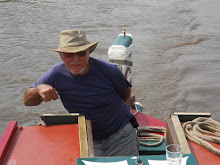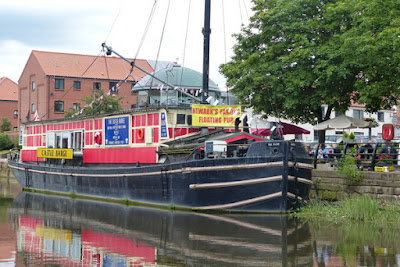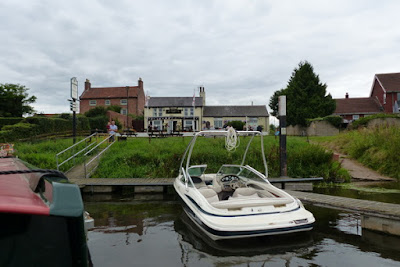Saturday
30th July.
I
left Gunthorpe pontoon at 10.00, passing through Gunthorpe Lock, with
a plan to get through Newark before mooring again, although Newark seemed
pleasant enough for a nights mooring. There was still evidence of the malting
industry along the waterfront and the castle was right alongside the cut, with
plenty of history to its name. The main Trent watercourse bypasses the town and
a cut flows through it with only two locks, Town Lock and Nether Lock at the
far end.
 |
| Newark with the maltings on the waterside. |
Approaching Newark Town Lock.
Whilst
waiting for a large trip boat to come through Town Lock, I heard the following
VHF conversation, which I thought was highly amusing.
“Hazelford
Lock, this is cruiser Scintilla approaching you from downstream and requesting
permission to make passage through the lock in about ten minutes please – over.”
“Hazelford
to Scintilla, just lowering two boats through at this time, so ten minutes
would be fine –over.”
“Thank
you Hazelford, we will await the green light – out.”
“Hazelford
to Scintilla, when you release your mike button, it sounds like you are
strangling a parrot – over.”
“That’s
an optional extra Hazelford. If you want one, just let me know when I come in – out.”
Each lock keeper
wants to know if I am going through the next lock and if so, then they phone
ahead. If I intend stopping off at a mooring for the night, they inform the
next lockie that this is what is happening, so the passage of every boat is
kept under scrutiny all the way down the river.
Featureless for most of the way............
I had my eye on a
mooring at North Muskam, which was owned by a pub on the river bank, so
permission to moor had to be requested. Strangely, the pontoon was made up of
three finger moorings, so could accommodate six boats. I reversed in, watched
by the curious drinkers on the lawn and managed to do it without any mistakes.
This was The Muskham Ferry and was quite popular on this Saturday afternoon,
when the sun finally managed to show itself after a very overcast day. The mooring
situation on the river reminded me of The Flowerpot Inn at Aston, Nr. Henley-on-Thames.
Good choice of beers, but at 5.8%, that is even stronger than the Abbott at 5%.
The Muskham Ferry.
I phoned the lock
keeper at Cromwell Lock, which is at the head of the tideway, for a passage
time tomorrow, which will be between 08.00 and 08.30, which will take me 12
miles to Torksey, where I intend mooring on a pontoon in the lock cut. I have
decided to tackle the tideway in short hops, which gives me plenty of time
between each stop and there will be no rush to make the entrance to Keadby in
time to get over the cill, having just read a horror story about the same trip
attempted in a shorter time.
Sunday 31st
July.
The Tidal Trent.
Despite all the
trepidation of the last few days about tackling the tideway, I have to say that
the trip from Cromwell Lock to Torksey Lock was a doddle and no different to
the non-tidal river. Twelve miles achieved in a little over three hours, mostly
at 4mph; the fastest time towards the end being 5mph and that was at cruising
speed of 1500rpm all the way.
I radioed Cromwell
Lock on leaving the mooring and got there in good time, only to find that I was
about 15mins too early, so I managed to get 15mins water fill from the
awkwardly placed water point high up on the bank, which meant climbing a ladder
not only to moor up, but to also get the hose and rubbish up there as well. I
didn’t help that there was another boat moored adjacent to the water point too.
No sign of life on board, so I assumed they were still asleep.
There were two
other boats in the lock waiting for me and we went through together of course,
but after a while the cruiser astern of me passed by and soon disappeared. I
later passed the narrow boat ahead of me, who was going quite slowly, which
wasn’t surprising by the sound of his engine, which sounded like someone
shaking a tin of nails. We were all soon well apart and the sun was shining on
and off, though there was not a lot to see, due to the high flood banks, with
the occasional bridge or wharf coming into view. The only way to get a position
was to look out for the km posts that marked your distance along the way. Most
of the time I had the steering on auto pilot, i.e. a tiller string which keeps
the tiller straight ahead, making fine adjustments now and then, or taking it
off altogether when coming to a bend and there were a lot of those on this
stretch.
These lazy cows think they are on Brighton beach.
I had a racing
pigeon land on the cabin top; it had two rings, so I presume that is what it
was. This was the second pigeon in two days that had accompanied me for a
considerable distance. I can only assume that they need time to recover from a
long flight. Both were quite tame and came within two feet of me, not even
moving when I went down below.
A small deposit was left for his trip.
There were several hazards
on the trip that I had read about; one island and two sunken islands, but there
were large warning signs on the bank ahead of each hazard, so no mistaking the
position of each one.
When I was within
1km of Torksey Lock, I radioed the lock keeper, but without reply, so he was
almost certainly off duty. No worries because there is a long lock cut with
pontoons in the approach to the lock. The faster cruiser had been there about
30mins and the crew said they missed the lockie by about 15mins. He is due to
return at 17.00, so hopefully there will be enough water over the cill to lock
in shortly after that.
Talking to the
crews on the other two accompanying boats, I found out that the cruiser skipper
had only had the boat a week and although his starter battery worked, the
domestics were knackered as the boat had been idle for 6 months. Considering
all the care that I had taken to prepare for this tidal cruise, this guy had been
on his boat for only two days and was cruising tidal waters. The solo boater on
the ‘tin of nails’ was worried in case he could not restart his engine, because
his starter battery was also knackered. And to think I was worried having ten
years experience and several tideway trips on the Thames. Is it any wonder that
boaters get into trouble when they take chances like that?
Monday 1st
August.
Eventually, I was
able to find tide tables on the internet for various ports on the Trent – why do
they hide them away like that? I could also watch the level of the pontoon and
timed my departure just before high water, which was probably a little too
early, because when I got up to cruising speed (1500rpm) I was only doing 3mph
and I could observe the flow at the piers of the nearest bridge. Gradually, my
speed over ground increased to 4, 5 and eventually 6mph close to Gainsborough,
where there is a pontoon, but it is not visible from beneath the bridge,
Gainsborough Arches, because it is set back in a layby, which caused a bit of
panic. I slowed down to pass the pontoon and then made the turn, so as to come
up against the flow, drifting about 100yds downstream in the process of turning
against the ebbing tide. A live aboard boater came out to take my bow line and
I moored up safely with four lines out.
Gainsborough Arches, but where is the pontoon?
I got chatting to
him later and discovered that his prop shaft coupling had broken, causing the
propeller shaft to fly out and smash the fuel filter, so he was in the process
of bypassing the filter. Diesel had pumped out into the engine bilge. He has
also lost his boat keys and had to hot wire it to start, so the instrument panel
was open exposing all the wiring. When the engine had failed, he was coming
upstream on the flood tide and hit a bridge pier broadside on; fortunately he
was with another boat at the time. According to him, it was all a bit of a
laugh! How do these people get away with it? Maybe, if he spent the money on
his boat that he had spent on piercings and tattoos, it would have been in a
more seaworthy condition.
So, the trip this
morning was blessed with warm sunny weather and I enjoyed it, despite the
featureless banks of the River Trent. I am now out of CRT waters and entering those
of Associated British Ports, which are controlled by Humber Navigation By-laws.
The km markers have now come to an end at Gainsborough, so I will have to
navigate by landmarks from here on.










No comments:
Post a Comment